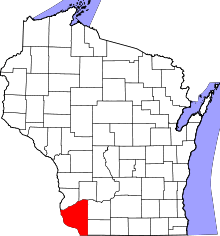Platteville, Wisconsin
| Platteville, Wisconsin | |
|---|---|
| City | |
|
Platteville Main Street | |
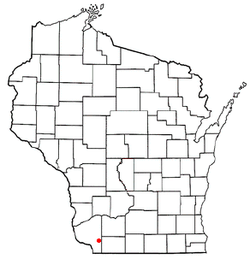 Location in Wisconsin | |
| Coordinates: 42°44′13.45″N 90°28′39.01″W / 42.7370694°N 90.4775028°WCoordinates: 42°44′13.45″N 90°28′39.01″W / 42.7370694°N 90.4775028°W | |
| Country |
|
| State |
|
| County | Grant |
| Government | |
| • City Manager | Larry Bierke |
| Area[1] | |
| • City | 5.45 sq mi (14.12 km2) |
| • Land | 5.45 sq mi (14.12 km2) |
| • Water | 0 sq mi (0 km2) |
| Elevation | 991 ft (302 m) |
| Population (2010)[2] | |
| • City | 11,224 |
| • Estimate (2012[3]) | 11,286 |
| • Density | 2,059.4/sq mi (795.1/km2) |
| • Metro | 49,681 |
| Time zone | CST (UTC-6) |
| • Summer (DST) | CDT (UTC-5) |
| Area code(s) | 608 |
| Website | http://www.platteville.org/ |
Platteville is the largest city in Grant County in southwestern Wisconsin. The population was 11,224 at the 2010 census, growing 12% since the 2000 Census. Much of this growth is likely due to the enrollment increase of the University of Wisconsin–Platteville. It is the principal city of the Platteville Micropolitan Statistical area which has an estimated population of 49,681.
History
Platteville was a small farming and fur trading community along the Platte River, from which the town got its name.[4] In the 1820s, lead ore or Galena was discovered in the area, a mining boom took the area by storm. The mining district encompassed a significant portion of southwest Wisconsin. More specifically, the counties of Grant, Iowa, Lafayette, and Jo Davies County (Illinois) played a major role in the mining of lead and zinc ore. The Galena, Illinois mining district, an area south of Platteville, had been known to many for years.[5] Beginning in 1825, lead prices saw a dramatic boost and the Platteville economy flourished.[6] The "grey gold" (a common nickname for lead ore) was brought development of businesses and schools. Platteville's landscape was shaped by the mining that helped build the town, and mineral holes abounded everywhere.[7]
By the 1849s lead ore production was decreasing. However, the mining of zinc ore quickly filled the void for prospective work. Platteville was now an established town, complete with schools, an academy, newspaper, several churches, and a telegraph service as of November 1849."[8]
During this time, a teachers' college and a mining college were founded. The Normal School was established on October 9, 1866.[9] The Wisconsin Mining Trade School opened in January 1908.[10] In 1959, these two colleges merged to become Wisconsin State College and Institute of Technology.[10] It was not until 1971 that the college became University of Wisconsin–Platteville, a school that specializes in engineering. Nowadays, UW Platteville is also considered the best criminal justice college in the mid-west.[10]
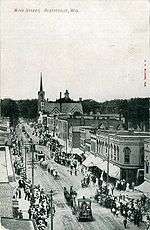
Today, Platteville is mainly a college town, with some development in the white-collar sector. That growth is a result of the increasing number of engineering firms locating in Platteville to take advantage of UW-P's engineering program.
From 1984 until 2001 the Chicago Bears football team held training camp on the campus of University of Wisconsin–Platteville. This resulted in a substantial infusion of money into the local economy each summer. That money stopped flowing after the Bears decided to hold training camp at Olivet Nazarene University in Illinois.
In 2004, the University of Wisconsin System gave its approval to the University of Wisconsin–Platteville's plan to expand the student enrollment from 5,000 to 7,500.
In 2004, U.S. Highway 151 was upgraded to a limited-access highway whose lanes run further south of Platteville, bypassing the city. Prior to the upgrade, the highway exits were closer to Platteville and Platteville has already made changes to adjust to the new southern US 151 bypass. A new hospital was built just north of US 151 and next to its off ramps. A Walmart Supercenter and a Menards have opened near the northern end of the US 151 bypass.
Historic buildings
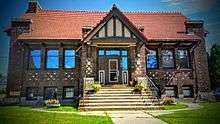
Geography
Platteville is located at 42°44′13″N 90°28′39″W / 42.73707°N 90.477501°W (42.73707, -90.477501).[11] It is in the Hollow Region, as named by early southern miners, in the rolling hills of southwestern Wisconsin.
According to the United States Census Bureau, the city has a total area of 5.45 square miles (14.12 km2), all of it land.[1]
Platteville is serviced by Wisconsin State Highways 80 and 81, as well as U.S. Highway 151. Originally, U.S. 151 went through the valley that made up the southern border of the city limits, but with the completion of the four-lane limited-access superhighway, traffic has been rerouted and now loops south of the city.
The minerals in the area consist of galena, a sulfide of lead (lead 86.6, sulfur 13.4). Sphalerite or zinc sulfide is also, common in the region. Zinc and lead mining were in heavy production through the 1820s – 1920s.[12] Consequently, there are few straight streets in Platteville. As a result of the mining in the 1800s, a honeycomb of abandoned old mines, streets were located to avoid the mines.
Climate
| Platteville | ||||||||||||||||||||||||||||||||||||||||||||||||||||||||||||
|---|---|---|---|---|---|---|---|---|---|---|---|---|---|---|---|---|---|---|---|---|---|---|---|---|---|---|---|---|---|---|---|---|---|---|---|---|---|---|---|---|---|---|---|---|---|---|---|---|---|---|---|---|---|---|---|---|---|---|---|---|
| Climate chart (explanation) | ||||||||||||||||||||||||||||||||||||||||||||||||||||||||||||
| ||||||||||||||||||||||||||||||||||||||||||||||||||||||||||||
| ||||||||||||||||||||||||||||||||||||||||||||||||||||||||||||
"Monthly Averages for Platteville, WI". MSN Weather. Retrieved 2009-03-18.
Demographics
| Historical population | |||
|---|---|---|---|
| Census | Pop. | %± | |
| 1870 | 2,537 | — | |
| 1880 | 2,687 | 5.9% | |
| 1890 | 2,740 | 2.0% | |
| 1900 | 3,340 | 21.9% | |
| 1910 | 4,452 | 33.3% | |
| 1920 | 4,353 | −2.2% | |
| 1930 | 4,047 | −7.0% | |
| 1940 | 4,762 | 17.7% | |
| 1950 | 5,751 | 20.8% | |
| 1960 | 6,957 | 21.0% | |
| 1970 | 9,599 | 38.0% | |
| 1980 | 9,580 | −0.2% | |
| 1990 | 9,708 | 1.3% | |
| 2000 | 9,989 | 2.9% | |
| 2010 | 11,224 | 12.4% | |
| Est. 2015 | 12,572 | [13] | 12.0% |
2010 census
As of the census[2] of 2010, there were 11,224 people, 3,644 households, and 1,598 families residing in the city. The population density was 2,059.4 inhabitants per square mile (795.1/km2). There were 3,840 housing units at an average density of 704.6 per square mile (272.0/km2). The racial makeup of the city was 94.7% White, 2.1% African American, 0.2% Native American, 1.7% Asian, 0.3% from other races, and 1.0% from two or more races. Hispanic or Latino of any race were 1.6% of the population.
There were 3,644 households of which 18.2% had children under the age of 18 living with them, 32.7% were married couples living together, 7.8% had a female householder with no husband present, 3.3% had a male householder with no wife present, and 56.1% were non-families. 31.4% of all households were made up of individuals and 11.6% had someone living alone who was 65 years of age or older. The average household size was 2.32 and the average family size was 2.80.
The median age in the city was 22.4 years. 11.3% of residents were under the age of 18; 49.4% were between the ages of 18 and 24; 14.3% were from 25 to 44; 14.3% were from 45 to 64; and 10.7% were 65 years of age or older. The gender makeup of the city was 56.3% male and 43.7% female.
2000 census
As of the census[15] of 2000, there were 9,989 people, 3,312 households, and 1,692 families residing in the city. The population density was 2,376.4 people per square mile (918.3/km2). There were 3,482 housing units at an average density of 828.4 per square mile (320.1/km2). The racial makeup of the city was 96.15% White, 1.12% Black or African American, 0.27% Native American, 1.40% Asian, 0.04% Pacific Islander, 0.27% from other races, and 0.75% from two or more races. 0.88% of the population were Hispanic or Latino of any race. There were 3,312 households out of which 22.2% had children under the age of 18 living with them, 40.0% were married couples living together, 8.0% had a female householder with no husband present, and 48.9% were non-families. 32.2% of all households were made up of individuals and 13.0% had someone living alone who was 65 years of age or older. The average household size was 2.31 and the average family size was 2.86.
In the city the population was spread out with 14.4% under the age of 18, 41.3% from 18 to 24, 17.5% from 25 to 44, 14.4% from 45 to 64, and 12.3% who were 65 years of age or older. The median age was 23 years. For every 100 females there were 119.3 males. For every 100 females age 18 and over, there were 120.6 males.
The median income for a household in the city was $35,742, and the median income for a family was $50,583. Males had a median income of $31,424 versus $21,896 for females. The per capita income for the city was $15,858. About 4.6% of families and 19.4% of the population were below the poverty line, including 12.2% of those under age 18 and 8.3% of those age 65 or over.
Transportation
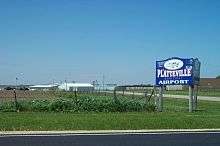
Platteville Municipal Airport (KPVB) serves the city and surrounding communities.
Education
The Platteville School District serves the Platteville area. Platteville High School is the area's public high school. Platteville High School's mascot is "Henry Hillmen". The University of Wisconsin–Platteville is located in Platteville.
Culture
The main source of culture in Platteville is the Center for the Arts on University of Wisconsin–Platteville campus, which sponsors a steady stream of well-attended professional touring events.
The "Heartland Festival", a semi-professional theater festival that produced four shows that run throughout the summer, was a summer attraction featured at the UWP-Center for the Arts. The casts were a combination of professionals and local residents.

Attractions
- The Mining and Rollo Jamison Museums
At the museums one can tour Lorenzo Bevan's 1845 lead mine, ride a 1931 zinc mine train, and view many exhibits on Platteville's mining history as well as Rollo Jamison's personal collection of artifacts.[16]
- Stone Cottage
Built in 1837 by the Rev. Samuel Mitchell, this home still contains many of the original furnishings. The home was a home of the Major John Rountree, one of Platteville's founders. The walls are two feet thick and made of dolomite Galena limestone.[17]
- The Big M
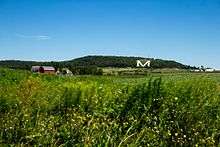
Platteville has the world's largest M, a claim that its Chamber of Commerce states is unchallenged. The M is a monogram for the former Wisconsin Mining School (now the University of Wisconsin–Platteville).
The first M was first constructed in 1936 when two men, Raymond Medley and Alvin Knoerr climbed the Platte Mound and trudged through 2 feet of snow to form a huge letter M. Actual construction of the stone M began in the spring of 1937 and was completed in the fall of the same year.
The M is composed of rocks laid on Platte Mound and is whitewashed (not painted) every year. The M is 241-feet tall, 214-feet wide and legs that are 25-feet wide.
The M can be seen many places in Platteville and sometimes in Iowa, on a clear day. Atop the Platte Mound and the M viewers can see three states: Wisconsin, Iowa, and Illinois.
The M is lit once a year during the University of Wisconsin – Platteville college homecoming. It is an attraction Platteville citizens generally appreciate.[17]
Notable people
- Scott Adams, early computer game publisher and designer
- John Fiedler, voice actor and character actor in stage, film, television and radio[18]
- Herbert Spencer Gasser, physiologist and recipient of the Nobel Prize for Physiology or Medicine in 1944
- Herbert T. Perrin, U.S. Brigadier General and Distinguished Service Cross recipient
- Josiah Little Pickard, educator
- Pants Rowland, manager of 1917 World Series champion Chicago White Sox[19]
Politicians
- William Carter, Wisconsin State Assemblyman
- S. Wesley Clark, Attorney General of South Dakota
- Kearton Coates, Wisconsin State Assemblyman
- Thomas Cruson, Wisconsin Territorial legislator
- James Dolan, Wisconsin State Assemblyman
- Ensign Dickinson, Wisconsin State Assemblyman
- Charles E. Estabrook, Wisconsin Attorney General
- Neely Gray, Wisconsin territorial legislator and businessman
- John L. Grindell, Wisconsin State Assemblyman
- Jon R. Guiles, Wisconsin State Assemblyman
- Thomas Jenkins, Wisconsin State Assemblyman
- Arthur W. Kopp, U.S. Representative
- James B. McCoy, Wisconsin State Assemblyman
- Duncan McGregor, Wisconsin State Assemblyman
- Ray Meiklejohn, Canadian politician
- Jonathan Baker Moore, Wisconsin State Assemblyman and Union Army general
- James William Murphy, U.S. Representative
- Hanmer Robbins, Wisconsin State Assemblyman
- Gordon Roseleip, Wisconsin State Senator
- John H. Rountree, Wisconsin State Senator
- A. C. Schultz, Wisconsin State Assemblyman
- George Slack, Wisconsin State Assemblyman
- Harry E. Stephens, Wisconsin State Assemblyman
- Robert S. Travis, Wisconsin State Senator
- Adelbert L. Utt, Wisconsin State Assemblyman
- James Russell Vineyard, Wisconsin and California politician
- Noah Virgin, Wisconsin State Senator
- Benjamin Webster, Wisconsin State Assemblyman
- Conrad J. Weittenhiller, Wisconsin State Assemblyman
Gallery
 Downtown Platteville at night
Downtown Platteville at night Bike rack depicting the Big M
Bike rack depicting the Big M Bike rack in downtown Platteville
Bike rack in downtown Platteville- Rountree Hall apartment complex (former Mining school)
See also
References
- 1 2 "US Gazetteer files 2010". United States Census Bureau. Retrieved 2012-11-18.
- 1 2 "American FactFinder". United States Census Bureau. Retrieved 2012-11-18.
- ↑ "Population Estimates". United States Census Bureau. Retrieved 2013-06-24.
- ↑ Chicago and North Western Railway Company (1908). A History of the Origin of the Place Names Connected with the Chicago & North Western and Chicago, St. Paul, Minneapolis & Omaha Railways. p. 114.
- ↑ Nesbit, Robert. Wisconsin A History. 2nd ed. The University of Wisconsin Press: Madison, 1989.
- ↑ Nesbit, 96.
- ↑ Fatzinger, 16.
- ↑ Hibbard, James. Images of America PLATTEVILLE, Arcadia Publishing, 2004.
- ↑ Hibbard, 37.
- 1 2 3 Hibbard, 83.
- ↑ "US Gazetteer files: 2010, 2000, and 1990". United States Census Bureau. 2011-02-12. Retrieved 2011-04-23.
- ↑ Fatzinger, Dale Rodger. "Historical Geography of Lead and Zinc Mining In Southwest Wisconsin 1820–1920: A Century of Change." PhD diss., Michigan State University, 1971.
- ↑ "Annual Estimates of the Resident Population for Incorporated Places: April 1, 2010 to July 1, 2015". Retrieved July 2, 2016.
- ↑ "Census of Population and Housing". Census.gov. Retrieved June 4, 2015.
- ↑ "American FactFinder". United States Census Bureau. Retrieved 2008-01-31.
- ↑ "Attractions". Mining museum. Retrieved 2009-12-23.
- 1 2 "Attractions". Platteville Chamber of Commerce. Retrieved 2009-12-23.
- ↑ O'Donnell, Michelle. "John Fiedler, 80, Stage Actor and Film Voice of Pooh's Piglet, Dies", New York Times, June 27, 2005. Accessed December 15, 2007.
- ↑ http://www.baseball-reference.com/managers/rowlapa99.shtml
External links
| Wikimedia Commons has media related to Platteville, Wisconsin. |
- City of Platteville
- Platteville Chamber of Commerce
- Platteville Mining Museum and Rollo Jamison Museum
- University of Wisconsin–Platteville
- Platteville Main Street Program
- Sanborn fire insurance maps: 1884 1892 1900 1908 1915
